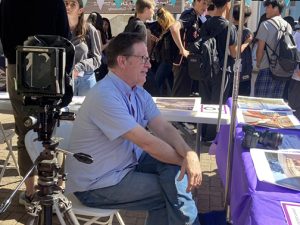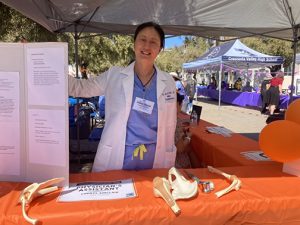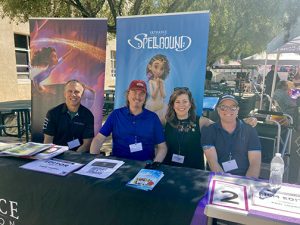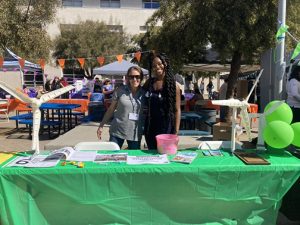
Photo by Mikaela STONE
One person’s perspective on being part of the high school career fair.
By Mikaela STONE
The thing no one tells you about writing is that the moment you get any better at it all of your old work starts to look like a child’s crayon ramblings. Yes, even the play you had once been proud of and the stories your professors had praised.
I spend the night before the Crescenta Valley High School career fair puttering around my living room, trying to decide what to print and wondering how many of my friends and mentors had lied to me. I print out one of my stories, read three quarters of it, and send a text to Phoebe: “Was the Selkie story always bad or am I just critical?” Selkies appear in Irish and Scottish folklore as part seal and part human. 2022 Mikaela had thought herself rather clever for making one part walrus.
“I’d have to read it again but I’d imagine you’re a) critical and b) you have evolved as a writer,” she responded.
We’d had some variation of this conversation dozens of times from both sides since we had met during our freshman year at UC Santa Barbara. Phoebe had worked no less than six unpaid jobs since our graduation in 2023. My short postgrad research position at UCSB ended when funds for humanities came up short. And now I was going to convince the students at my old high school that writing was a career path worth going into demonstrating with a short story I wasn’t proud of anymore? Then again, my friends in STEM were also struggling: dozens of interviews where they did not receive so much as a rejection email while all of our extended family claimed the real problem was “no one wanting to work anymore.” If you’re planning to be underpaid and under-hired, it ought to be for a field you love.
Besides, Robin and Mary at the Crescenta Valley Weekly would have told me already if I was a bad writer. Right?
I reread my short story, find two counts of the word “breast” and decide high schoolers aren’t ready for Aegis the walrus woman anyway.
The next morning I settle myself at my spot at the purple-clothed Entertainment and Media table. While I wait for the students to arrive, I set out my play in its binder, a stack of CV Weekly internship applications, the article on Berlin politics I wrote while studying abroad and an infographic for The Society of Children’s Book Writers and Illustrators that I had designed myself – thank you very much. For good measure, I stick a paper in my play binder that reads “Ask Me About ‘A Fairy Queen Came To My Birthday And All I Got Was This Lousy Curse!’”
The man sitting next to me asks about “A Fairy Queen Came To My Birthday And All I Got Was This Lousy Curse!”
He says his name is Jason Beeber and it takes me longer than it should have to realize he had not called himself “Justin Beiber.”
“It’s my middle grade novel,” I reply. “There’s too much romance in children’s fiction. Like, you have 12 year olds finding their forever person. So it’s a friendship fairy tale.”
I don’t tell him that I had scrapped the thing four times on account of the whole “getting better than I had been at writing previously” thing.
“What do you do?” I ask him.
He has a small mountain of bags, magnets and notebooks. His cardboard trifold is doing bloody battle with the wind.
“I work at ‘Make that Paper’ podcasts. Our first podcast was called ‘Make that paper.’ It’s about artists’ side hustles – what they do to make money. You know,” he nods to my reporter’s badge.
I did know.
“I’m also a face painter,” I said. (Publisher Robin had warned me from the start what my pay would be.) “It’s all good though,” I rush to assure Beeber. “I actually like my boss.”
“I’m my own boss, so I can’t say the same,” he laughs. “HR isn’t much help either.”
He goes on to tell me about the podcasts he and his wife are producing: “The Girl With the Same Name” about the murder of Jamie Stickle, a cold case that followed his wife of the same name – Jamie Stickle – around for years, and a tarot podcast for all levels of belief and talent.
Cameron Carothers takes his seat beside me next lugging a camera and a stack of glossy prints from his commercial real estate photography.

Of all the people to sit next to me! The very play sitting on my table featured a lead character written specifically for his youngest to perform.
Looking around, I realized I recognized more than half of the gathered professionals. They were band parents and volunteers who worked other events I had attended in addition to the careers they now represented.
Cheryl Sinclair, physician’s assistant at Kaiser Permanente, is the mom of one of my brother’s good friends. Seeing her in her scrubs was like running into my old kindergarten teacher in an Ikea. She presides over a stack of model bones, challenging onlookers to identify them.

I try not to be starstruck by Rob Vogt, sitting in front of a cheery animated banner for Skydance Animation’s recent movie “Spellbound.” As a specialist in animation and production technology, he worked on over 20 animated films for Skydance and Dreamworks, including “Shrek” and “Madagascar.” Somehow he finds the time to help out with my brother’s Boy Scout troop.

The community has pulled out all the stops for the first career fair since 2019.
Finally, the students arrive.
Carothers pulls no punches when answering questions.
“How do I become a freelance photographer?” asks one student.
“Start taking pictures,” he answered. “You don’t need to go to college for it unless you require that kind of structure and, if you do, being a freelancer probably won’t work out for you.”
One of the prospective photographers comes over to me.
“Do you take photos for your job?”
“Yes –” I begin.
“Oh yeah!” He shoots a fist into the air and grabs one of the internship applications before running off into the crowd.
Students trickle in and out.
“Who is the most famous person you’ve ever interviewed?” asks one student.
“Senator Anthony Portantino,” I answered.
The student looks a little disappointed when I don’t say a star. I consider mentioning interviewing Rodney Allen Rippy for Black History Month, but Rippy’s famous Jack in the Box commercials were well before my time – never mind the student’s.
Another student confesses that she likes the idea of journalism but there are so many options she is considering.

I remember my own mentors’ advice. Studying abroad in Berlin with Nomi Morris had been a treat. She had been there when the Berlin Wall fell, working as a foreign correspondent.
“The best reporters have too many interests,” she had told me. “It makes you good at interviewing anyone.”
Next a few members of the CVHS journalism course arrive to ask me how I got into journalism.
“I wasn’t until I got this job,” I admit. “I studied creative writing and literature in college. I only applied to the Crescenta Valley Weekly because it seemed interesting. After I started interviewing people, I realized how much I enjoyed it. So many of the people I interview have fascinating life passions they are devoted to.”
The next question startles me: “Do you find working at a small paper fulfilling?”
“I do. I really do. Some of my favorite things are cozy news,” I answer. “Things like ‘Local Man is so nice he is voted mayor of Two Strike Park.’ That was a real story I did. And then there was the therapy dog for the firefighters – Cooper. When I studied in Berlin, the article I worked on was about the German response to Gaza. There any perceived criticism of Israel could be perceived as antisemitism. People lost their jobs for protesting. It’s important, but high stakes.”
“Maybe you could come into our class and tell our classmates what you told us,” said a student. “I bet they’d find what you have to say interesting.”
I agree to stay in contact. It was hard not to respect these students, already working hard at building their writing skills.
At lunch break, I confess to volunteer and band mom Wendy Tateishi that it was strange to tell these students that, unlike them, I hadn’t known since high school that I wanted to be a reporter. I had always been focused on children’s book writing and literature analysis.
“That’s good for them to see,” she responded. “Right now, the job market is about being flexible and applying skills to lots of different niches.”
As the fair continues, I notice three tables that were paid a large amount of attention. The JPL display was by far the most visited table and it was no wonder. The scientists had arrived with beautiful art of the cosmos and NASA stickers, causing boys and girls in equal measure to gravitate toward them. Overwhelmingly, female students seem to show interest in the behavioral and speech therapy tables, stocked with games and tools the therapists use to grab young clients’ interest, and the male students focused on the military table. As I watch, a small crowd gathers on the rough stone of the quad to impress the stiff-shouldered recruiters with how long they can hold a plank.
While I am closer in age to the students than the military officers, the students look far different than when I went to CVHS. Baggy jeans have replaced leggings and chunky sneakers have replaced flats. In spite of it all, I spot the same pair of Cookie Monster pajama pants my peers once favored.
I also recognize one student’s T-shirt: Hazbin Hotel, a popular adult animated musical TV show.
The boy’s face lights up when I compliment it and he holds out his hand for my notebook. In less than a minute he sketches one of the main characters. (If you’re reading this, Dude, thank you again!)
The biggest shock comes when a student stops short at the sight of my face.
“Are you the Mikaela Stone who volunteered with Mrs. Meguerditchian’s class?”
“Yes I am,” I said. I had volunteered at Lincoln Elementary when I was in high school.
“I was in that class!” She pointed to her face. “Abby.”
I did remember an Abby, but that Abby was half this Abby’s height and missing teeth.
“Oh my goodness! You grew!” is all I can think of to say.
Surely it hadn’t been long enough for that second grader to turn into a freshman. Surely that math couldn’t be right!
Mrs. Meguerditchian had been my second grade teacher back when she was Miss Bakamjian. This passage of time thing was likely twice as strange for her with Abby in high school and me graduated from college.
Mrs. Meguerditchian had been one of the first to encourage my writing. Sitting on her classroom’s rainbow floor rug, listening to her read Robert Munsch picture books to us, I knew I wanted to write something that she could read to her students.
The advice of incredible mentors like her, Robin Goldsworthy, Mary O’ Keefe, and Nomi Morris is something I will continue to be proud of (even when I have progressed in skill and this essay makes me wince).
